
A camcorder is a self-contained portable electronic device with video and recording as its primary function. It is typically equipped with an articulating screen mounted on the left side, a belt to facilitate holding on the right side, hot-swappable battery facing towards the user, hot-swappable recording media, and an internally contained quiet optical zoom lens.

High-Definition Multimedia Interface (HDMI) is a proprietary audio/video interface for transmitting uncompressed video data and compressed or uncompressed digital audio data from an HDMI-compliant source device, such as a display controller, to a compatible computer monitor, video projector, digital television, or digital audio device. HDMI is a digital replacement for analog video standards.
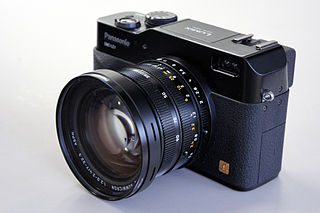
Lumix is Panasonic's brand of digital cameras, ranging from pocket point-and-shoot models to digital SLRs.
AVCHD is a file-based format for the digital recording and playback of high-definition video. It is H.264 and Dolby AC-3 packaged into the MPEG transport stream, with a set of constraints designed around the camcorders.
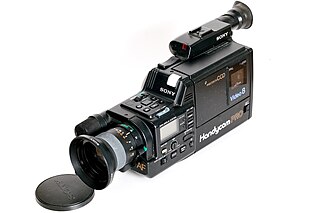
Sony Corporation produces professional, consumer, and prosumer camcorders such as studio and broadcast, digital cinema cameras, camcorders, pan-tilt-zoom and remote cameras.

The Venus Engine is an image-processing engine for digital cameras. It is developed by the company Panasonic. Almost all of their Lumix cameras use a version of the Venus Engine. It is based on the Panasonic MN103/MN103S.
Mobile High-Definition Link (MHL) is an industry standard for a mobile audio/video interface that allows the connection of smartphones, tablets, and other portable consumer electronics devices to high-definition televisions (HDTVs), audio receivers, and projectors. The standard was designed to share existing mobile device connectors, such as Micro-USB, and avoid the need to add video connectors on devices with limited space for them.
Uncompressed video is digital video that either has never been compressed or was generated by decompressing previously compressed digital video. It is commonly used by video cameras, video monitors, video recording devices, and in video processors that perform functions such as image resizing, image rotation, deinterlacing, and text and graphics overlay. It is conveyed over various types of baseband digital video interfaces, such as HDMI, DVI, DisplayPort and SDI. Standards also exist for the carriage of uncompressed video over computer networks.

The Panasonic Lumix DMC-GH1 is a digital mirrorless interchangeable lens camera adhering to the Olympus and Panasonic developed Micro Four Thirds System (MFT) system design standard. Panasonic classified the GH1 as a hybrid stills/video camera and the GH1 was introduced and marketed as a higher end camera than Panasonic's first MFT camera, the stills only, non-video capable Lumix DMC-G1.
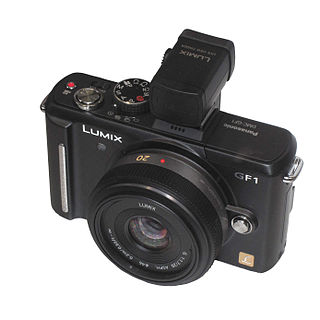
Panasonic Lumix DMC-GF1 was introduced in September 2009 as the third camera in Panasonic's Lumix G-series, using the Micro Four Thirds system. It was the first model in the "GF" line, which is primarily distinguished from the other Lumix G cameras by the lack of an integrated electronic viewfinder.
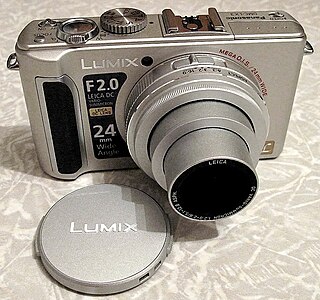
The Panasonic Lumix DMC-LX3, or LX3, is a high-end compact "point and shoot" camera launched by Panasonic in late 2008 to succeed the Lumix LX2.
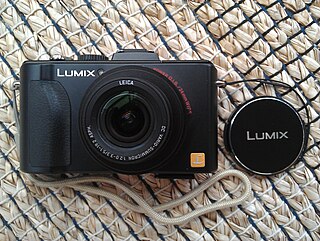
The Panasonic Lumix DMC-LX5, or LX5, is a high-end compact "point and shoot" camera launched by Panasonic in 2010 to succeed the LX3.

The Panasonic Lumix DMC-GH3 is a digital mirrorless interchangeable lens camera (MILC) manufactured by Panasonic. It is the successor to the Panasonic Lumix DMC-GH2 and was announced in September 2012 at photokina. It was available from November 2012.

The Panasonic Lumix DMC-LX7, or LX7, is a high-end compact "point and shoot" camera launched by Panasonic in 2012 to succeed the LX5.

The Panasonic Lumix DMC-FZ1000 is a digital superzoom bridge camera by Panasonic. It went on sale in June 2014. It has a 20 megapixel 3:2 BSI-CMOS sensor and Leica-branded 25–400 mm equivalent focal length lens with a maximum aperture of f/2.8 to f/4. It has a 1-inch CMOS sensor and supports ISO film speeds from 80 to 25600, shutter speeds from 1/16000 s to 60 s and RAW capture, while the lowest physical shutter speed is 1/4000 s. The unit is equipped with five "Fn" function buttons which can be allocated to custom shortcuts.
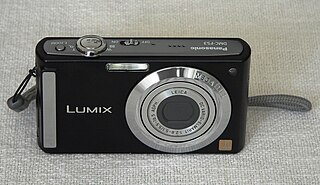
The Panasonic Lumix DMC-FS3 is a digital ultracompact camera announced by Panasonic on January 29, 2008. It has eight megapixels, triple optical zoom, 16:9 wide VGA video recording at 30 frames per second, versatile scene modes, and an accelerometer sensor for orientation tagging.
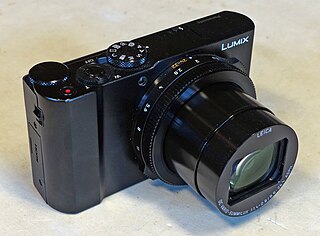
The Panasonic Lumix DMC-LX10 is a 20 MP 1" sensor compact camera in the Lumix range, announced by Panasonic on September 19, 2016. LX10 features an F1.4–2.8 equivalent Leica-branded zoom lens, 3" 1040k dot LCD, built-in flash, built-in wireless, and it can record 4K video at 30p or Full HD at 60p. The LX10 is more compact than the Panasonic LX100 or GX8 series by not having an electronic viewfinder, interchangeable lenses, or hot shoe. The camera is typically compared to the Sony RX100 series.














